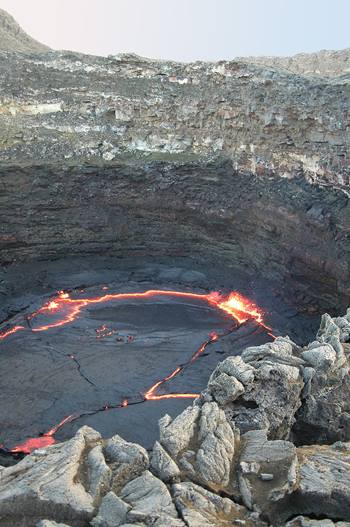East African Rift Valley, East Africa

The East African Rift Valley (EAR) is a developing divergent plate boundary in East Africa. Here the eastern portion of Africa, the Somalian plate, is pulling away from the rest of the continent, that comprises the Nubian plate. This extension has formed a rift valley, similar to the morphology of the one we see at the Vale of Eden albeit much younger! Crustal extension has formed a series of elongate lowland valleys bound by steeply dipping normal faults, separated by regions of comparatively high land. The Nubian and Somalian plates are also separating from the Arabian plate in the north, thus creating a ‘Y’ shaped rifting system. These plates intersect in the Afar region of Ethiopia at what is known as a ‘triple junction’.
The EAR formed in the Miocene approximately 25 million years ago; originating at the Afar triple junction and extending southwards over time. It currently extends for 3500 km from the Red Sea to Mozambique and is formed from two broadly parallel main rift branches: the eastern rift which passes through Ethiopia and Kenya and the western rift, which runs in an arc from Uganda to Malawi.
 |
|
| Map of the East African Rift Valley © USGS |
Both the eastern and western rifts are characterized by volcanic activity, brittle faulting and large asymmetric half graben systems filled with river and lake sediments . The eastern branch, thought to have formed first in the early Miocene, is a volcanic-rich system that forms the Kenya and Ethiopian Rifts and contains the shield volcano Erta Ale which has an active lava lake. The western branch, thought to have formed later in the Miocene has a series of extensive deep and shallow lakes, including Lake Tanganyika, the 2nd deepest lake in the world. It has comparatively less volcanic activity but has much deeper earthquakes and is considered to be more seismically active. In general, the western branch can be regarded as a good model of a young continental rift system while the eastern branch is representative of a “failed” mature continental rift system.
The orientation of the rifts, highlands and associated flood basalts in the Afar region indicate that the EAR most likely formed as the result of elevated heat flow from the asthenosphere beneath Kenya and Ethiopia. This increased heat caused the regions to uplift resulting in stretching and fracturing of the brittle continental crust. Flood basalts erupted through fissures and a series of normal faults were generated, creating the classic ‘horst and graben’ morphology of elongate basins and associated highlands, which now make up the rift valley. The source of this elevated heat flow is under debate but most geologists agree that it is related to mantle plume activity heating the overlying crust and causing it to expand and fracture.
 |
|
| The lava lake in the caldera of Erta Ale: © Rolf Cosar |
Today the EAR remains above sea level however in the future, as extension continues along the rift, the rift valley will sink lower and lower eventually allowing ocean waters to flood into the basin. If rifting continues, new basaltic oceanic crust may form along the centre of the rift producing a new narrow ocean basin with its own mid ocean ridge between the Nubian and Somalian plates.
Whilst both the Vale of Eden and the East African Rift Valley are formed by continental rifting they are formed in response to different crustal processes. The Eastern rift branch is a magmatic rift dominated by volcanism and formed by an ascending mantle plume bringing hot asthenosphere (the upper layer of the earth's mantle, below the lithosphere) to shallow crustal levels. The Vale of Eden is a sedimentary rift with extension related to plate stretching and more comparable to the Western rift branch.
* Further reading:
* Morley et al. 1999, Introduction to the East African Rift System, in C.K. Morley ed., Geoscience of Rift Systems—Evolution of East Africa: AAPG Studies in Geology No. 44, p. 1–18.
